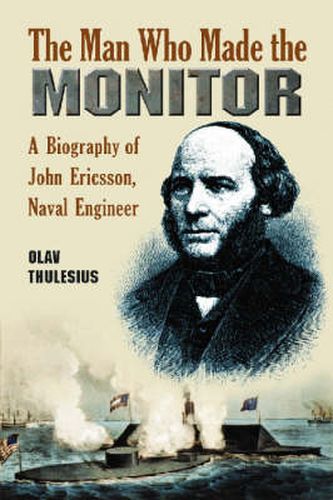Readings Newsletter
Become a Readings Member to make your shopping experience even easier.
Sign in or sign up for free!
You’re not far away from qualifying for FREE standard shipping within Australia
You’ve qualified for FREE standard shipping within Australia
The cart is loading…






This title is printed to order. This book may have been self-published. If so, we cannot guarantee the quality of the content. In the main most books will have gone through the editing process however some may not. We therefore suggest that you be aware of this before ordering this book. If in doubt check either the author or publisher’s details as we are unable to accept any returns unless they are faulty. Please contact us if you have any questions.
Mention Civil War naval confrontations and the Monitor instantly springs to mind. The first of the ironclads, the Monitor not only took part in a major battle, it forever changed the face of naval construction. But who was the man behind the ship? Born in Filipstad, Sweden, in 1803, the brilliant and somewhat eccentric engineer John Ericsson spent his childhood observing his father’s work in mining and later learned his engineering skills at the North Atlantic-Baltic canal. As a young man Ericsson turned to a variety of projects. In England, he introduced the ship’s propeller, built an Arctic expedition vessel and designed some of the first successful steam locomotives. Moving to New York in 1839, he soon teamed up with Harry Cornelius Delameter of the Phoenix foundry, a partnership which resulted in Ericsson’s most famous work, the USS Monitor. Focusing on the man behind the inventions, this book tells the life story of John Ericsson. It details a number of Ericsson’s inventions including a steam-powered fire engine, the first screw-propelled warship, a variety of hot-air engines, and early experiments in solar power from the roof of his Manhattan home. The main focus is Ericsson’s design and construction of the ironclad USS Monitor. One of the first viable armored warships, the Monitor revolutionized naval warfare the world over. The ship’s battle with the CSS Virginia at Hampton Roads and its eventual fate off the coast of Cape Hatteras are covered. Ericsson’s relationships with contemporaries such as Alfred Nobel and recent developments concerning the recovery of the wreck of the Monitor are also examined.
$9.00 standard shipping within Australia
FREE standard shipping within Australia for orders over $100.00
Express & International shipping calculated at checkout
This title is printed to order. This book may have been self-published. If so, we cannot guarantee the quality of the content. In the main most books will have gone through the editing process however some may not. We therefore suggest that you be aware of this before ordering this book. If in doubt check either the author or publisher’s details as we are unable to accept any returns unless they are faulty. Please contact us if you have any questions.
Mention Civil War naval confrontations and the Monitor instantly springs to mind. The first of the ironclads, the Monitor not only took part in a major battle, it forever changed the face of naval construction. But who was the man behind the ship? Born in Filipstad, Sweden, in 1803, the brilliant and somewhat eccentric engineer John Ericsson spent his childhood observing his father’s work in mining and later learned his engineering skills at the North Atlantic-Baltic canal. As a young man Ericsson turned to a variety of projects. In England, he introduced the ship’s propeller, built an Arctic expedition vessel and designed some of the first successful steam locomotives. Moving to New York in 1839, he soon teamed up with Harry Cornelius Delameter of the Phoenix foundry, a partnership which resulted in Ericsson’s most famous work, the USS Monitor. Focusing on the man behind the inventions, this book tells the life story of John Ericsson. It details a number of Ericsson’s inventions including a steam-powered fire engine, the first screw-propelled warship, a variety of hot-air engines, and early experiments in solar power from the roof of his Manhattan home. The main focus is Ericsson’s design and construction of the ironclad USS Monitor. One of the first viable armored warships, the Monitor revolutionized naval warfare the world over. The ship’s battle with the CSS Virginia at Hampton Roads and its eventual fate off the coast of Cape Hatteras are covered. Ericsson’s relationships with contemporaries such as Alfred Nobel and recent developments concerning the recovery of the wreck of the Monitor are also examined.